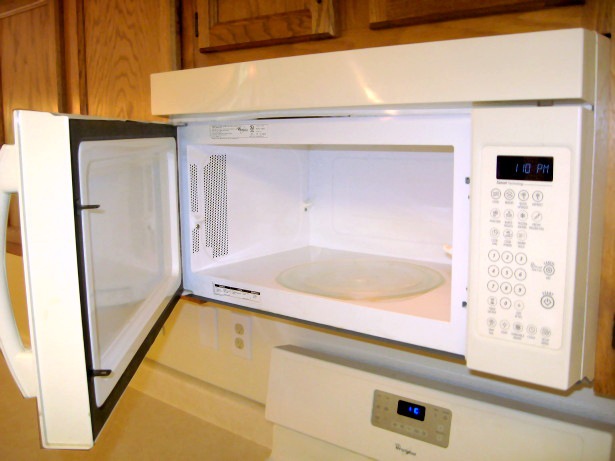A microwave oven emits a type of electromagnetic radiation called microwaves. These waves are similar to radio waves, but they have shorter wavelengths and higher frequencies. When microwaves hit an object, they cause the molecules in that object to vibrate.
This is how microwaves heat up food. The amount of microwaves emitted by a microwave oven varies depending on its power output and the amount of time it is turned on. However, all microwave ovens emit some level of radiation.
In general, the more powerful the microwave oven, the more radiation it emits.
When it comes to appliances that emit radiation, microwaves are often at the top of the list. But just how much radiation does a microwave emit?
The answer may surprise you.
While microwaves do emit radiation, it is actually very low on the electromagnetic spectrum. In fact, the amount of radiation emitted by a microwave is about 1000 times lower than that of a cellphone.
So, while there is some risk associated with using microwaves, it is far from being one of the most dangerous devices out there.
Just be sure to use yours in moderation and you’ll be fine.

Credit: wtamu.edu
Does a Microwave Emit Radiation?
Yes, a microwave emits radiation. This is how it works: microwaves are a type of electromagnetic radiation, which means they are waves of electric and magnetic energy that travel through the air at the speed of light. When microwaves hit an object, they cause the molecules in that object to vibrate.
The vibration of these molecules creates heat, which is why microwaves can be used to cook food. Microwave ovens work by using electricity to generate microwaves inside the cooking chamber. The microwaves bounce around until they are absorbed by the food, which is what causes it to heat up and cook.
So yes, microwaves do emit radiation, but it is non-ionizing radiation, which means it does not have enough energy to break apart atoms or molecules. This type of radiation is not known to cause any harmful effects in humans.
How Far Away from Microwave is Safe?
When it comes to microwaves, the general rule of thumb is to keep them at least six inches away from your body. This is because microwaves emit electromagnetic radiation, which can be harmful if you are exposed to too much of it. However, there is no need to worry about this if you simply use your microwave in moderation and keep it at a safe distance from your body.
Can a Broken Microwave Leak Radiation?
When it comes to microwaves, the biggest concern is usually food safety. But another potential hazard is radiation leakage. So, can a broken microwave leak radiation?
The short answer is yes, a broken microwave can leak radiation. However, the amount of radiation that leaks out is usually not enough to pose a health risk. Microwave ovens work by using electromagnetic waves to heat food.
These waves are produced by an electron beam that travels back and forth inside the oven chamber. The walls of the chamber are made of metal mesh that allows the waves to pass through but reflects most of the heat so it stays inside the oven (this is why you don’t get burned when you open a microwave door). When everything is working correctly, the microwaves are contained within the chamber and posed no threat to anyone outside of it.
However, if there’s a crack or hole in the chamber walls, microwaves can escape and potentially cause harm to people nearby. There have been some reports of people experiencing negative health effects after being exposed to leaking microwaves, but these claims are largely unproven. It’s worth noting that most studies on microwave radiation have found no evidence of adverse health effects at levels below those considered hazardous (2).
So while it’s possible that a broken microwave could leak harmful levels of radiation, it’s unlikely. If your microwave does happen to develop a crack or hole, it’s best to replace it rather than try to repair it yourself. Not only could you be exposing yourself to dangerous levels of radiation, but you could also end up causing further damage to your appliance (and possibly your home) in the process.
Are Microwaves Dangerous? – Your Worst Fears Confirmed
Is Microwave Radiation Harmful to Humans?
Most people are familiar with microwave ovens, which use microwave radiation to heat food. But did you know that microwave radiation is also used in cell phones, Wi-Fi routers, and other wireless devices? Despite its widespread use, there is some controversy over whether or not microwave radiation is harmful to human health.
Some studies have linked exposure to microwave radiation with an increased risk of cancer, while other studies have found no such link. So what does the science say? At this point, it’s hard to say for sure whether or not microwave radiation is harmful to humans.
More research is needed to determine the potential risks and benefits of exposure to this type of radiation. In the meantime, if you’re concerned about your exposure to microwaves, there are some steps you can take to minimize your risk.
Does a Microwave Emit Radiation When off?
When it comes to microwaves, there are two main types of radiation: ionizing and non-ionizing. Ionizing radiation is the kind that can cause damage to DNA, and has been linked to cancer. Non-ionizing radiation cannot damage DNA, but can still cause other health problems.
So, does a microwave emit radiation when it’s turned off? The answer is yes, but only a very small amount. In fact, the amount of radiation emitted by a microwave when it’s turned off is so low that it’s not considered dangerous.
However, if you’re pregnant or have any other health concerns, it’s best to err on the side of caution and keep your distance from any sources of electromagnetic radiation, just in case.
Can Microwaves Cause Cancer?
For years, there has been debate about whether or not microwaves can cause cancer. Some people are convinced that they do, while others believe that there is no evidence to support this claim. So, what is the truth?
Can microwaves really cause cancer?
The short answer is that we don’t know for sure. There is no definitive proof that microwaves cause cancer, but there are some studies that suggest a possible link.
One study found that rats exposed to microwave radiation had an increased risk of developing brain tumors. However, it’s important to note that this study was funded by the cell phone industry and has been heavily criticized by other scientists.
Another study looked at people who work in close proximity to microwave ovens (such as cooks and bakers) and found a slightly increased risk of developing leukemia.
However, this study did not take into account other factors that could have contributed to the leukemia risk (such as exposure to chemicals).
So, while there is some evidence to suggest a possible link between microwaves and cancer, it’s far from conclusive. More research is needed before we can say for sure if microwaves are dangerous or not.
In the meantime, it’s probably best to err on the side of caution and limit your exposure to microwave radiation just in case.
Safe Distance from Microwave Oven
When it comes to microwave ovens, the general rule of thumb is to keep a safe distance of at least three feet. This means that you should never stand directly in front of the microwave while it is on, and you should also avoid standing too close to it when it is not in use.
The reason for this is that microwave ovens emit electromagnetic radiation, which can be harmful to your health if you are exposed to too much of it.
While the amount of radiation emitted by a microwave oven is relatively low, it is still important to take precautions to avoid being overexposed.
So, next time you go to heat up your food in the microwave, make sure you step back a few feet and give yourself some breathing room!
Conclusion
A microwave oven emits a form of electromagnetic radiation called microwaves. These waves are similar to radio waves, but they have a shorter wavelength and higher frequency. Microwaves are used to heat food by causing water molecules in the food to vibrate.
The vibration produces heat that cooks the food.
Most microwaves sold in the United States are required to meet safety standards set by the Federal government. These standards limit the amount of microwaves that can leak from an oven during its use.
In addition, manufacturers must provide consumers with information about potential risks associated with using microwave ovens.

Asma Sheikh is a food and recipe blogger who loves to cook and bake. Her blog, “Kitchen Crunch”, is all about sharing her recipes with the world. Asma has been cooking and baking since she was a little girl, and she loves to share her passion with others. She believes that anyone can cook, no matter their skill level, and she enjoys helping others to learn new techniques and recipes.

